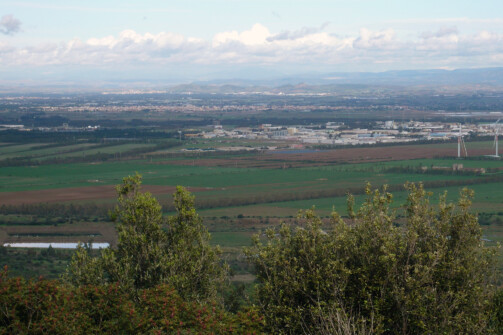Assemini rises in the plains behind Cagliari, where the Rio Cixerri and the Flumini Mannu flow into the large Santa Gilla lagoon, and its territory reaches as far as Monte Arcosu in the heights that limit the Campidano to the west.
Within a radius of a few kilometers there are two very different natural environments, rich in flora and fauna. In the lagoon, in fact, among the reeds, rushes and saltmarshes one can admire many species of fascinating marsh birds: pink flamingos, herons, and then egrets, moorhens, coots, ducks and the rare sultan chicken. It is an incredible heritage, that of the Santa Gilla lagoon, which has recently been enhanced as part of the Gilia Project. Now visitors have nature trails, with protected stations so as not to disturb. From here they can admire from a few meters the life and flights of these wonderful animals, free and wild in their natural environment. And a project that respects and protects nature, making it an attraction for everyone, not just birdwatchers. Among the mountains, on the other hand, protected within the Monte Arcosu Natural Oasis, in the valley of Gutturu Mannu and Guttureddu, the Mediterranean scrub, and the forest of centuries-old holm oaks, cork oaks and carob trees that are home to Sardinian deer and wild boar and over which the golden eagle can be seen flying. It was logical that such a place, with land for cultivation and fresh water, close to a fishy lagoon and mountains rich in game, should have been inhabited since ancient times. In fact, in the Assemini territory there are traces of human presence since prehistoric times, such as the pre-Nuragic village found in the area of S. Andrea. At the foot of Mount Lattias, near the beautiful perennial spring of Mitza Fanebas are the remains of the Nuragic village of the same name, with the nuraghe marked by time at its center. From the Punic period remains a necropolis, located in the locality of Cuccuru Macciori, which in the 1980s was the subject of excavations and archaeological tests during which 300 tombs were found, of which only three were brought to light. Also from the same period is a sandstone block well known as the “Funtana ‘e Canabis” in the gardens of Via Trieste, and a villa in the “Is Chios” area.
After the Romans came the Byzantines, then the Arabs, of whom there are in the place names numerous testimonies and an important funerary stele exhibited in the Archaeological Museum of Cagliari. Then, the city was part of the Giudicato of Cagliari and then of the Pisan rule. When Pisa and the Kingdom of Aragon contended Cagliari fought each other right near Assemini, in the decisive battle of Lucocisterna.
Those who visit Assemini find traces of those centuries that are still part of the life of the town and its people: these are its ancient churches. In the historic center one can admire the Parish Church of St. Peter the Apostle, from the first half of the 11th century but rebuilt in the 16th century in Gothic-Aragonese style, the Oratory of St. John built between the 9th and 11th centuries in late Byzantine style, with a Greek cross plan. More recent are the 17th-century church of San Cristoforo and the church of Sant’Andrea, patron saint of fishermen, located at the entrance to the town on S.S. 130, belonging to the 18th century but of a very simple, rustic, timeless beauty. Traditionally Assemini is a town of farmers and artisans, and once also of fishermen from the lagoon. Today it is still an area of fields and gardens, with agriculture specializing in greenhouse and floricultural crops, of manufacturing activities located in the industrial zone of Macchiareddu. In its workshops, wood and wrought iron are worked and fine baskets are produced. But Assemini and famous above all as the town of ceramics and potters, an art for which it has obtained the recognition of “City of ancient tradition of ceramics DOC Mark.” Here the masters of the potter’s wheel produce table, kitchen or decorative objects with ceramics according to ancient techniques or by experimenting with new ones, with the spirit of the craftsman who never stops learning. The town has dedicated a permanent market exhibition to this art that also displays other handicrafts from the area, an ideal place to discover all forms of local tradition. Assemini is also famous among foodies for one of its dishes: the Panada, a dough pie baked in a wood-fired oven filled with eels or meat, with potatoes and peas. It is shaped like a small pot, edged with a decorative pattern that serves to unite the two discs of dough that make it up. And like a summary of the country’s tradition: it brings together the gifts of the lagoon and the fields and transforms them into a dish as beautiful as a pottery gilded by a wood-burning oven. For this special production, the Mountain Community has promoted the creation of the seal of quality. ( From the institutional website of the Municipality of Assemini)



